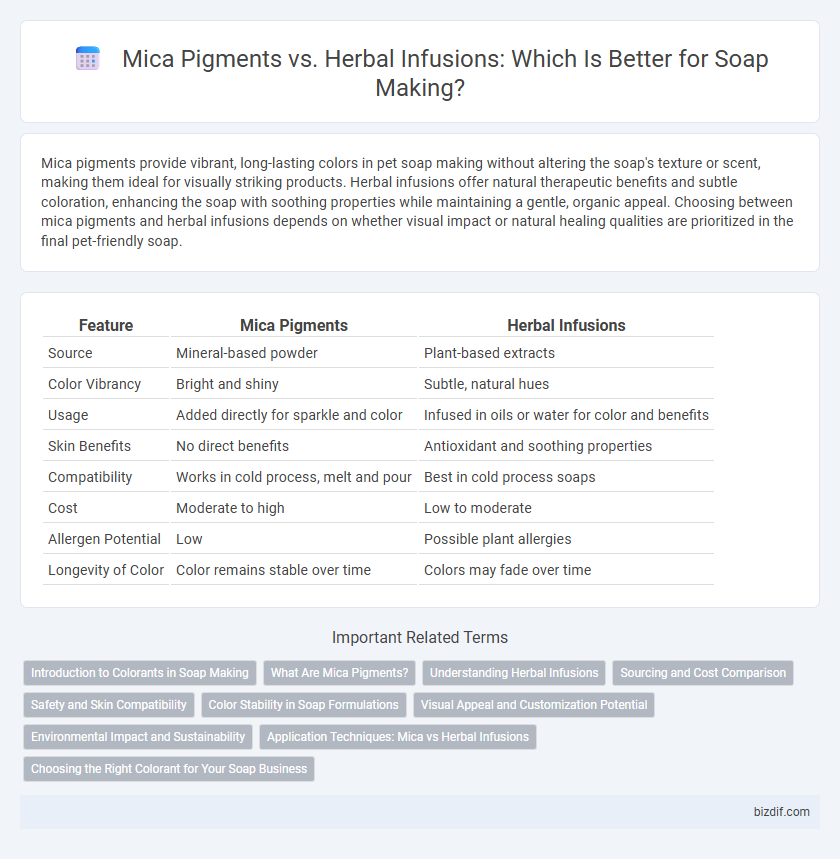Mica pigments provide vibrant, long-lasting colors in pet soap making without altering the soap's texture or scent, making them ideal for visually striking products. Herbal infusions offer natural therapeutic benefits and subtle coloration, enhancing the soap with soothing properties while maintaining a gentle, organic appeal. Choosing between mica pigments and herbal infusions depends on whether visual impact or natural healing qualities are prioritized in the final pet-friendly soap.
Table of Comparison
| Feature | Mica Pigments | Herbal Infusions |
|---|---|---|
| Source | Mineral-based powder | Plant-based extracts |
| Color Vibrancy | Bright and shiny | Subtle, natural hues |
| Usage | Added directly for sparkle and color | Infused in oils or water for color and benefits |
| Skin Benefits | No direct benefits | Antioxidant and soothing properties |
| Compatibility | Works in cold process, melt and pour | Best in cold process soaps |
| Cost | Moderate to high | Low to moderate |
| Allergen Potential | Low | Possible plant allergies |
| Longevity of Color | Color remains stable over time | Colors may fade over time |
Introduction to Colorants in Soap Making
Mica pigments in soap making provide vibrant, consistent, and long-lasting color with a wide range of shades that do not fade over time. Herbal infusions offer natural, subtle hues derived from botanical ingredients, imparting gentle color alongside potential skin benefits. Understanding the differences between these colorants helps soap makers choose between bold synthetic vibrancy and organic, eco-friendly options.
What Are Mica Pigments?
Mica pigments are natural mineral powders used in soap making to add vibrant, shimmering colors without fading or dissolving in the lye solution. These pigments offer a wide range of hues and intense sparkle effects, making them ideal for decorative soaps. Unlike herbal infusions, mica pigments do not alter the soap's scent or texture, providing consistent and visually appealing results.
Understanding Herbal Infusions
Herbal infusions in soap making introduce natural plant extracts that enhance therapeutic properties and impart subtle, earthy tones to the soap. Unlike mica pigments, which provide vibrant, consistent color through mineral powders, herbal infusions offer antioxidant benefits and gentle fragrances derived from botanicals like chamomile, lavender, or rosemary. Using herbal infusions requires careful temperature control during the soap-making process to preserve the potency and color of the herbs.
Sourcing and Cost Comparison
Mica pigments are mined minerals processed for vibrant, consistent colors and are generally more expensive due to extraction and refinement costs. Herbal infusions derive from dried plant materials steeped in oils or water, offering natural hues at a lower cost with variable color intensity dependent on herb quality and availability. Sourcing mica involves regulated mineral deposits, whereas herbal infusions rely on agricultural supply chains that fluctuate seasonally and regionally.
Safety and Skin Compatibility
Mica pigments offer vibrant, long-lasting color in soap making while maintaining high skin compatibility due to their inert mineral composition and non-toxic nature. Herbal infusions provide natural antioxidants and soothing properties but carry a higher risk of skin sensitivity or allergic reactions because of their complex botanical compounds. Careful patch testing and selecting reputable suppliers ensure safety when incorporating either mica pigments or herbal infusions into soap formulations.
Color Stability in Soap Formulations
Mica pigments offer superior color stability in soap formulations due to their inorganic mineral composition, which resists fading and oxidation over time. Herbal infusions, while providing natural hues and added skin benefits, tend to exhibit less consistent color retention because plant-based pigments can degrade when exposed to heat, light, and alkalinity. Selecting mica pigments ensures vibrant, long-lasting colors, whereas herbal infusions may result in muted or shifting tones throughout the curing process.
Visual Appeal and Customization Potential
Mica pigments offer vibrant, metallic shimmer and precise color control, making them ideal for creating visually striking soap designs. Herbal infusions provide natural, earthy hues and subtle variations, enhancing soap with organic textures and a soft, botanical aesthetic. Customization potential is higher with mica pigments due to their consistent intensity and mixability, while herbal infusions deliver unique, unpredictable patterns linked to specific plant properties.
Environmental Impact and Sustainability
Mica pigments, derived from mineral sources, often involve mining processes that can lead to habitat disruption and environmental degradation, raising sustainability concerns in soap making. Herbal infusions use plant-based materials that are typically renewable and biodegradable, resulting in a lower ecological footprint and supporting sustainable sourcing practices. Choosing herbal infusions over mica pigments can enhance the environmental sustainability of soap products by minimizing resource extraction and promoting natural ingredient cycles.
Application Techniques: Mica vs Herbal Infusions
Mica pigments provide vibrant, shimmering colors that are best applied by dry mixing into soap batter or dispersing in oil for consistent, intense hues. Herbal infusions offer natural, muted tones and are incorporated by steeping herbs in oils or water before blending into the soap base, enhancing both color and therapeutic properties. The choice between mica pigments and herbal infusions depends on desired visual effects and the infusion of natural benefits within the final soap product.
Choosing the Right Colorant for Your Soap Business
Mica pigments offer vibrant, consistent hues and excellent stability, making them ideal for soap makers seeking bold, long-lasting colors that resist fading over time. Herbal infusions provide natural, subtle shades with added skin benefits, appealing to eco-conscious customers looking for organic and gentle ingredients in their soaps. Selecting the right colorant depends on your target market's preferences, desired aesthetic, and formulation requirements for durability and safety.
Mica Pigments vs Herbal Infusions Infographic

 bizdif.com
bizdif.com